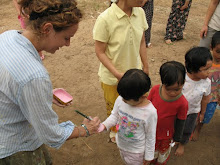Shooting Out A Root
Since the South East Asian reunion of the scattered yipyiping Scripps graduates, life has unfolded into a generous clump of adventures.
First, we allied with time and conquered space by finding each other in Singapore in late September, unwittingly overlapping with the first-ever night time Formula 1 Races.
While this made it virtually impossible to find a room, it did have its advantages.
In response to the swarming crowds, the citystate (while normally immaculately groomed and conspicuously sleek) was cloaked in perfectly placed glitter and visually stimulating treats designed to impress tourist eyeballs.Tengku Mahmud School in Terengganu offered different delights.

We team-taught a lesson dubbed "Each One, Teach One,"which had students draw blind contour portraits of each other and then fill them in with colours and writing about all the different things they wanted to teach and to learn. One student wanted be a computer hacker. Another, "to be the perfect boyfriend." Teaching skills included the cooking of various dishes, playing of assorted sports, and "how to die." The students were exuberantly shy and some spontaneous autograph sessions exploded at the end of classes.
We also painted a mural.
"The Promise Tree" encouraged students to make environmentally friendly decisions, while igniting constant joy in its aesthetic value.
There were some sad goodbyes, especially with the women that worked in the canteen, as they generously nurtured me in that warm dirty kitchen.
Our next stop was Southern Thailand, where we spent days in Chaomai--a small town of sea-gypsies,

and met a human named Sinchai (owner of Sinchai's Resort).
Our first 12 hours: Sinchai served us beers rather late at night and then surprised us by beating on our door yelling "wakeupwakeupwakeup!" at 6:30am the following day. He then forced us to eat and get on a boat, promising us we would be happy. We were. After several hours of groggy snorkeling, we swam through a pitch black cave tunnel and emerged into a pristinely turquoise lagoon in the middle of limestone cliffs.
and met a human named Sinchai (owner of Sinchai's Resort).
Additionally, we saw the sky compromise in a overwhelmingly attractive manner:
simultaneous pastel moon rise
Phnom Penh is a heavy city, with history coating the air like coarse dust. S-21 was an old high school that the Khmer Rouge converted into a torture and interrogation prison during the genocide in the late 70's. From this place I learned about the US's extensive bombing of Cambodia during the Vietnam war, and the sickening extent of human cruelty.

Pray not Prey
The Killing Fields was where many Cambodians were mass murdered during the four-year genocide that wiped out 20% of the country's population--particularly the educated. It is unnerving to walk in this quiet green place and try to fathom the atrocities that occured underneath the neutral trees and the sweet breeze that softens the brutal sun.

The reflection of sky over the skull-filled monument. This fresh history is still festering in all elements of Cambodian life, although it is constantly glossed over in Angkor Wat...
Angkor What?
Siem Reap is a crumbling town littered with the majestic ruins of 1000 year old stone temples. Blocks tumble into cubist landscapes.
Now, many of them are undergoing green redecoration of the natural variety, the tentacles of trees prying walls apart and dividing human effort with patient strength.
Also, the poverty of Cambodia has birthed a are a host of the most inspiring NGO's here. We stumbled onto an amazing organization to educate and empower street children, called The Global Child. We were able to do Past, Present, and Future self-portraits with the kids, and various stories spilled onto brightly colored paper.
I also fell head over heels in love with Saray Tonle, an organization which empowers women to weave sellable products out of water hyacinth, an invasive plant taking over the Tonle Sap Lake. In this way, the plant's harmful effects are curbed, the women make money using this abundant resource, instead of fishing the shrinking fish population, which is another environmental issue. So good.
Once again I'm inspired about the power of art to impact positive change,






















